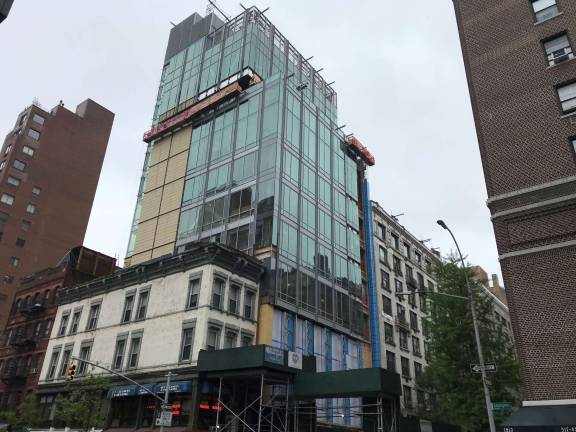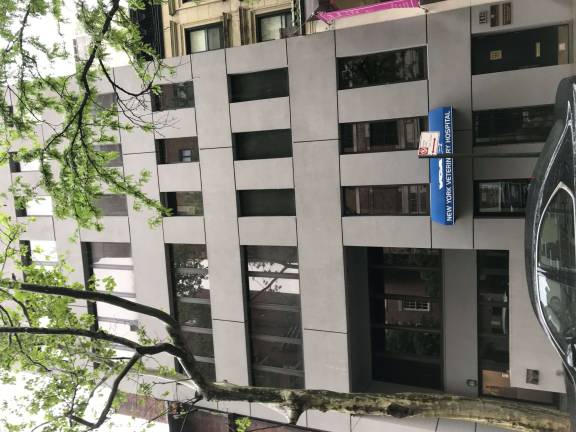a sephardic boom on the UES


A 14-story, $65 million building now wrapping up construction on East 82nd Street between Lexington and Park Avenues reflects a sea change in Jewish life on the Upper East Side — and the arrival and maturity of a new and deeply religious populace.
When the Moise Safra Community Center opens its doors this fall, it will quickly become the premier social, spiritual, educational, recreational, cultural and culinary center for the fast-growing Sephardic set pouring into Manhattan.
Designed to cater largely to Orthodox Jews of Syrian ancestry, the Safra Center — in its programming, ambition and vision, if not its budget — will inevitably be likened to the 92nd Street Y. Or at least a more religious version of the historically Ashkenazi institution that now serves people of all faiths on its Lexington Avenue campus just 10 blocks to the north.
The 169-foot-tall, 73,000-square-foot structure will operate as a vertical campus packed with two synagogues, three kosher cafes, a swimming pool, library, fitness center, wellness center and two sprawling outdoor terraces, plans filed with the city's Department of Buildings show.
Shoehorned into a tight urban space that once housed three adjoining townhouses, the center will become one of the busiest buildings in town: It boasts study rooms, lecture rooms, prayer rooms, ballrooms, a dining lounge, bike storage, art classrooms and studios for dance and yoga.
Looking for a place to host weddings or bar mitzvahs? Try the two-level banquet hall. Want your kids to make the best kibbe hamda — or Syrian stuffed meatballs afloat in lemony stew — west of Damascus? Visit the test kitchen, warming pantry or cooking classrooms. Keen on aquatic sports? Head for the below-grade pool and its nearby pool deck.
Over a month-long period, Safra Center executives declined several requests for interviews and a tour, saying they weren't yet ready to tell their story publicly.
That didn't dampen enthusiasm for the center's debut. At Congregation Or Zarua, a Conservative synagogue directly across 82nd Street, Rabbi Scott N. Bolton is rolling out the metaphorical red carpet for a place where Jews of all backgrounds are welcome to participate.
“It's East meets West, and Sephardi meets Ashkenazi,” the rabbi said. “We look forward to cooperative ventures, block parties at holiday times, and an increased traffic in programming that will create a Jewish buzz on the block.”
The Safra Center will be the largest, grandest Sephardic entrant to reshape religious and communal life on the UES. But it won't be alone.
Its launch comes amid a surge in the population of Jews whose families trace their roots to the Mid-East, North Africa and the Mediterranean Basin — and who have recently been putting down stakes in the East 60s, 70s, 80s and low 90s.
Those migratory waves — of Syrian Jews leaving Ocean Parkway in Brooklyn, Persians moving out of Great Neck, Moroccans emigrating from Morocco — have led Sephardic developers to build or advance plans for numerous houses of worship, schools and community centers, an Our Town review of construction activity and interviews with rabbis found.
“We're putting down roots here, we're building here, we've invested here, we have everything we need right here,” said Rebecca Harary, who was the Safra Center's founding executive director and Republican nominee for an East Side City Council seat in 2017.
Her story is emblematic of the outflow of Syrian Jewry from Midwood in Brooklyn: An empty-nester with four of her six children married and a fifth leaving for college, she and her husband, Joe, made a tentative move to the UES seven years ago. They never looked back.
Harary and other communal leaders say roughly 1,500 to 2,500 families have made similar moves to the East Side. The typical Syrian family averaging three to six kids, but the population's growth is so recent that census estimates haven't yet documented it.
Hundreds of the new arrivals appear to have followed a path blazed by Rabbi Elie Abadie, a spiritual entrepreneur and builder of synagogues who was born in Beirut, raised in Mexico City and hails from an old rabbinical line that passed through Turkey and Syria after the expulsion of Jews from Spain in 1492.
Just last November, he opened a pop-up house of worship, Manhattan East, or Congregation Shaare Mizrah, in temporary quarters on Third Avenue at 71st Street for primarily Syrian and Lebanese congregants. By the fall, it's expected to relocate into permanent new digs at an unspecified location between East 65th and 75th Streets, he said.
“At the very beginning, when the Upper East Side community first got started, you had this phenomenon where young couples would stay for a year, or two years or three years, before moving out to Brooklyn or the suburbs,” Rabbi Abadie said.
“Now, they stay forever. And then, their parents move in to be near their children,” he added.
Followers credit the rabbi for much of that growth. He founded the Edmond J. Safra Synagogue on East 63rd Street in 2003, also for Syrian Jews, and then in 2011, helped to establish the KJ Sephardic Minyan, at Congregation Kehilath Jeshurun on 85th Street.
He was also the rabbinic advisor to the Moise Safra Center, as well as its double-height synagogue, Ohel Moshe, and although he's no longer connected to the project, it brings to four the tally of synagogues he's founded in one neighborhood over 15 years.
“When I first came to the Upper East Side, you literally had to look on the streets to find Jewish men” of Sephardic background to make up a Minyan, meaning the 10 men over the age of 13 needed for traditional Jewish prayer services, Rabbi Abadie said. “Now, hundreds of people come.”
Naturally, that created the need for a school for their kids, and so in 2010, the rabbi founded the Sephardic Academy of Manhattan, an early childhood program on Second Avenue and 67th Street.
Of course, the toddlers and other pre-schoolers got a few years older, and thus, in January of this year, the Academy announced it was buying a six-story building at 148-150 East 74th Street, now the home of the New York Veterinary Hospital, to house a planned elementary school.
Cost: $14 million. Anticipated completion of the expansion school: 2020.
“Now, we have the school, the shul and the pool,” Harary said. “And those are the three main things that make a community.”
Meanwhile, other neighborhood mainstays are bursting at the seams, including Manhattan Sephardic Congregation on East 75th Street, the largely Moroccan synagogue founded by Rabbi Raphael Benchimol in 1990 as the first the first full-time Sephardic synagogue on the UES.
“This community is continually growing, and as more centers and institutions are being built, the more it can be expected to grow,” the rabbi said.
invreporter@strausnews.com